HIV AIDS epidemiology and demographics: Difference between revisions
Sergekorjian (talk | contribs) |
Sergekorjian (talk | contribs) |
||
| Line 99: | Line 99: | ||
===Treatment=== | ===Treatment=== | ||
People receiving | People receiving antiretroviral therapy in actual and projected figures are plotted in a graph and depicted below according to WHO statistics from 2003- 2015. | ||
[[File:Actual and projected number of people receiving ART.png|thumb|center|500px| <SMALL><SMALL> ''[(http://www.who.int/hiv/data/art_2003_2015.png?ua=1)]''<ref name="WHO">{{Cite web | title = World health organization (WHO) | url = http://www.who.int/hiv/data/art_2003_2015.png?ua=1}}</ref></SMALL></SMALL>]] | [[File:Actual and projected number of people receiving ART.png|thumb|center|500px| <SMALL><SMALL> ''[(http://www.who.int/hiv/data/art_2003_2015.png?ua=1)]''<ref name="WHO">{{Cite web | title = World health organization (WHO) | url = http://www.who.int/hiv/data/art_2003_2015.png?ua=1}}</ref></SMALL></SMALL>]] | ||
UNAIDS and the WHO estimate that AIDS has killed more than 25 million people since it was first recognized in 1981, making it one of the most destructive pandemics in recorded history. Despite recent improved access to antiretroviral treatment and care in many regions of the world, the AIDS pandemic claimed an estimated 2.8 million (between 2.4 and 3.3 million) lives in 2005 of which more than half a million (570,000) were children. | UNAIDS and the WHO estimate that AIDS has killed more than 25 million people since it was first recognized in 1981, making it one of the most destructive pandemics in recorded history. Despite recent improved access to antiretroviral treatment and care in many regions of the world, the AIDS pandemic claimed an estimated 2.8 million (between 2.4 and 3.3 million) lives in 2005 of which more than half a million (570,000) were children. | ||
==Epidemiology== | ==Epidemiology== | ||
| Line 160: | Line 159: | ||
Overall, in 2009, African American men had the highest rate of new HIV infections (103.9 new infections per 100,000 persons), followed by Hispanic/Latino men (39.9 per 100,000), and African American women (39.7 per 100,000). <ref>http://www.cdc.gov/hiv/topics/surveillance/incidence.htm</ref> | Overall, in 2009, African American men had the highest rate of new HIV infections (103.9 new infections per 100,000 persons), followed by Hispanic/Latino men (39.9 per 100,000), and African American women (39.7 per 100,000). <ref>http://www.cdc.gov/hiv/topics/surveillance/incidence.htm</ref> | ||
==References== | ==References== | ||
Revision as of 17:34, 30 October 2014
|
AIDS Microchapters |
|
Diagnosis |
|
Treatment |
|
Case Studies |
|
HIV AIDS epidemiology and demographics On the Web |
|
American Roentgen Ray Society Images of HIV AIDS epidemiology and demographics |
|
Risk calculators and risk factors for HIV AIDS epidemiology and demographics |
Editor-In-Chief: C. Michael Gibson, M.S., M.D. [1] ; Associate Editor(s)-in-Chief: Ammu Susheela, M.D. [2]
Overview
HIV is now a pandemic. In 2007, an estimated 33.2 million people lived with the disease worldwide, and it claimed the lives of an estimated 2.1 million people, including 330,000 children. Over three-fourths of these deaths occurred in sub-Saharan Africa, retarding economic growth and destroying human capital. Antiretroviral treatment reduces both the mortality and the morbidity of HIV infection, but routine access to antiretroviral medication is not available in all countries.[1]
HIV/AIDS stigma is more severe than that associated with some other life-threatening conditions and extends beyond the disease itself to providers and even volunteers involved with the care of people living with HIV.[2]
In 2010, an estimated 34 million people were living with HIV, of whom more than 30 million were living in low- and middle-income countries.
Epidemiology and Demographics
Incidence
In 2005, approximately 5 million people were newly infected with HIV and approximately 3 million people with AIDS died, an increase from 2004 and the highest number since 1981 (UNAIDS, 2005). In 2013, approximately 6000 new individuals were infected with HIV every day . [3]
- About 700 were in children under 15 years of age.
- 68% of those were in Sub Saharan Africa.
- About 5200 were adults ages 15 years or older of whom:
- About 33% were among young people (15-24)
- Almost 47% were among women
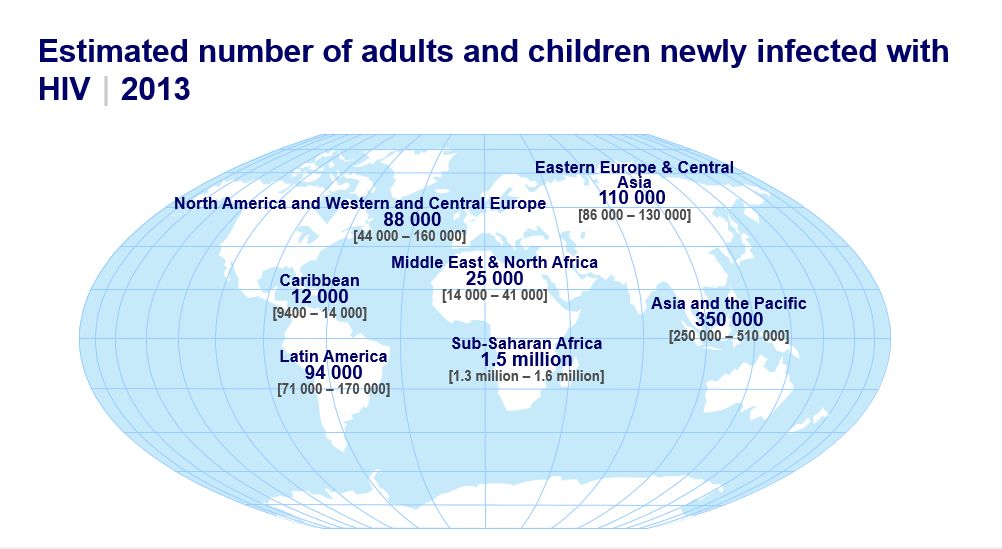
Prevalence
UNAIDS and the WHO estimate that AIDS has killed more than 25 million people since it was first recognized in 1981, making it one of the most destructive epidemics in recorded history.
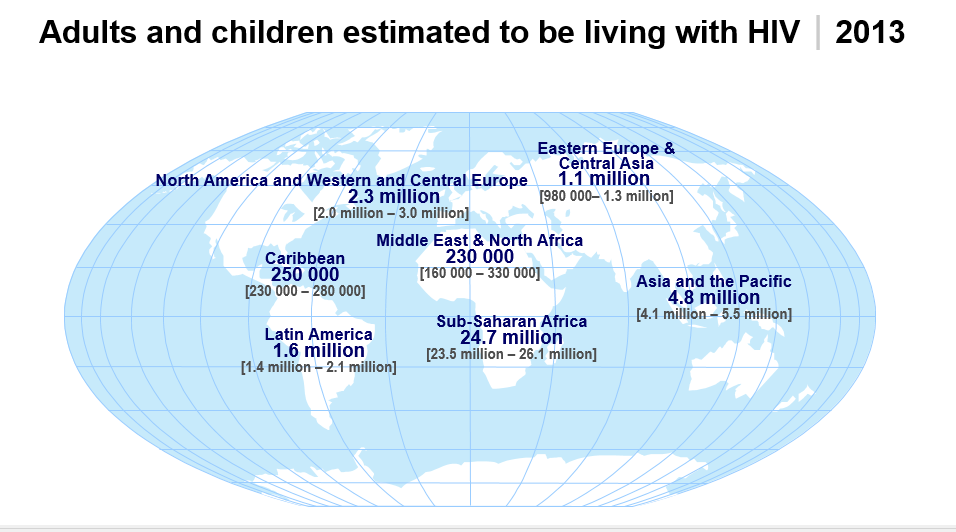
In 2013, the prevalence estimates were as follows:
- Total = 35 million
- Adults = 31.8 million
- Women = 16 million
- Children (<15 years) = 3.2 million
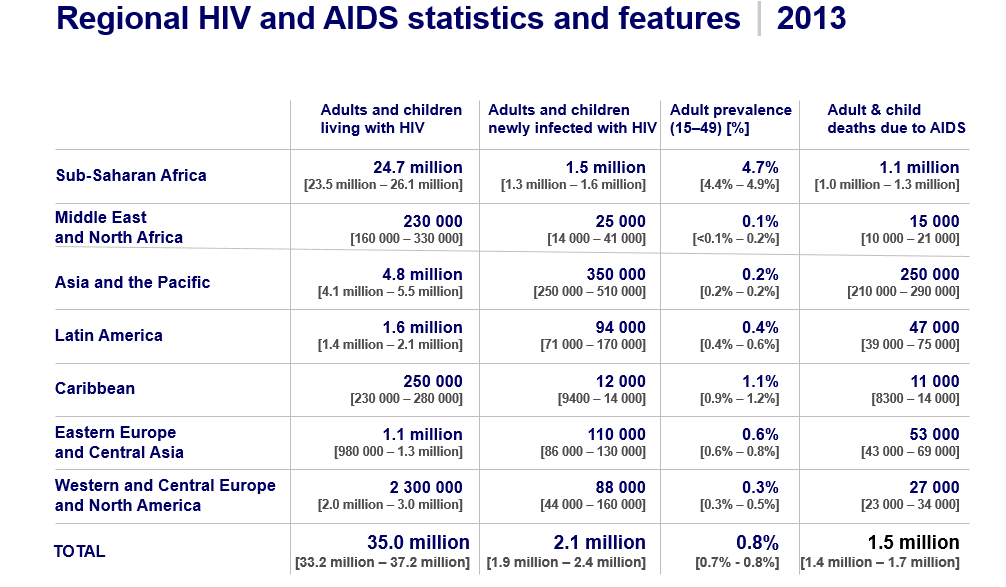
Age
Globally, an estimated 2.5 million children are living with HIV. An estimated 400,000 children are infected yearly.[4]
The following table demonstrates the estimated number of AIDS diagnoses in the United States in 2011 distributed by age at time of diagnosis:
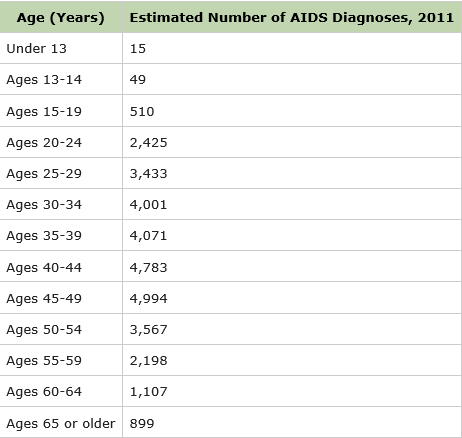
Gender
In the United States, males are more commonly affected than females. This may be related to the higher prevalence of HIV in homosexual men.
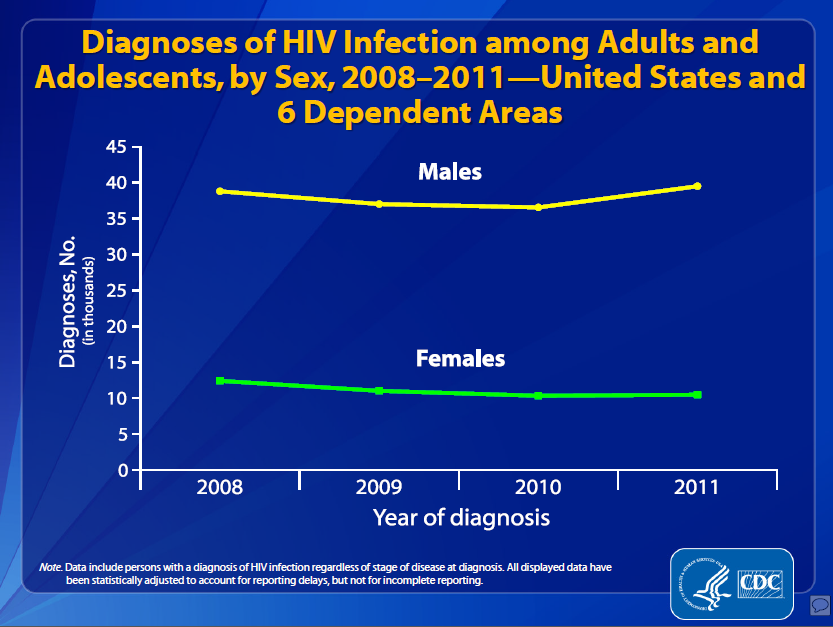
Prevalence by Mode of Transmission
The most common method of transmission is sexual contact. Unprotected male-to-male sexual contact is the major factor, followed by unprotected male-to-female sexual contact.
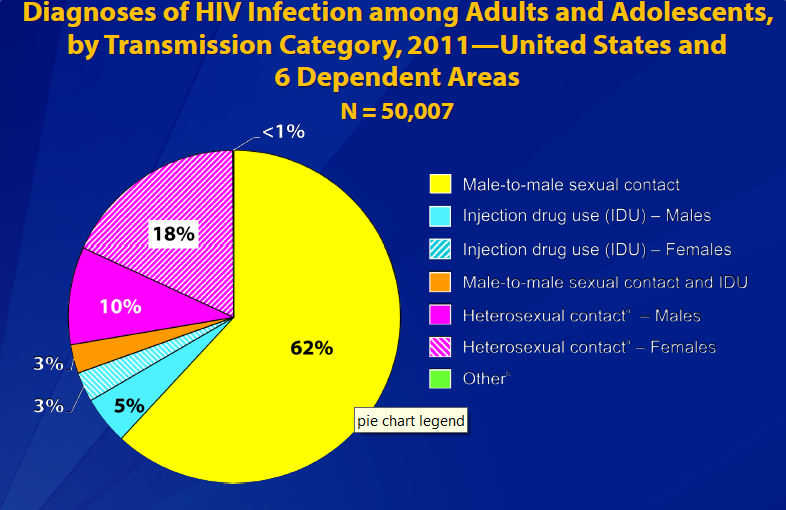
Race/Ethinicity
In the United States, HIV is most common among African-American males and females from Native Hawaiian and other Pacific Islander origins.
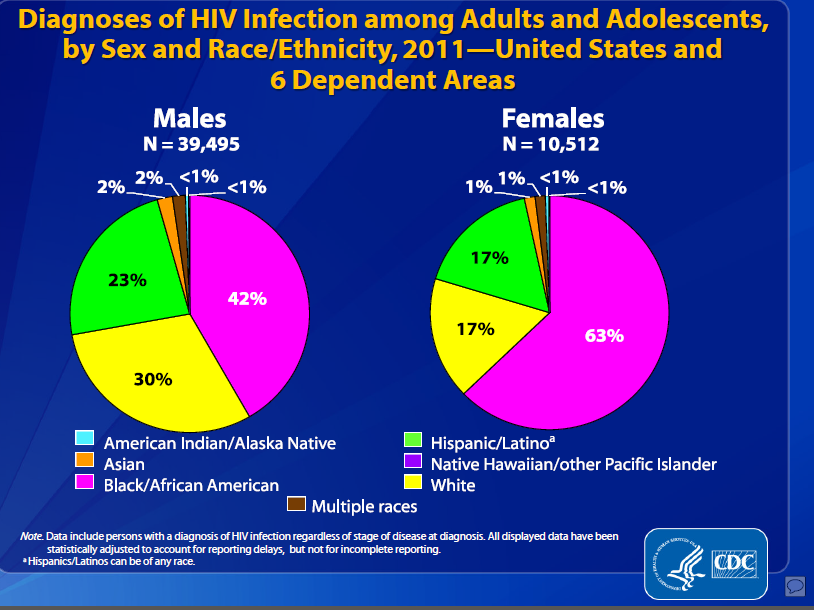
Developing Countries
Sub-Saharan Africa remains by far the worst affected region, with an estimated 23.8 to 28.9 million people currently living with HIV. More than 60% of all people living with HIV are in Sub-Saharan Africa, as are more than three quarters (76%) of all women living with HIV.
In 2007, Sub-Saharan Africa accounted for 76% of all AIDS deaths and approximately 35% of all new infections worldwide. Unlike other regions, most people living with HIV in sub-Saharan Africa in 2007 (61%) were women. Adult prevalence in 2007 was an estimated 5.0%, and AIDS continued to be the single largest cause of mortality in this region.[4] South Africa has the largest population of HIV patients in the world, followed by Nigeria and India.[6] South & South East Asia are the second worst affected regions; in 2007, an estimated 18% of all people living with AIDS, and an estimated 300,000 deaths from AIDS were attributable to these regions.[4] The estimated adult prevalence of AIDS in India is approximately 0.36%.[4] Life expectancy has fallen dramatically in the worst-affected countries; for example, in 2006 it was estimated that it had dropped from 65 to 35 years in Botswana.[7]
Mortality
The total number of deaths in 2013 according to the WHO were as follows:
- Total = 1.5 million
- Adults = 1.3 million
- Children (>15 years) = 190,000
Treatment
People receiving antiretroviral therapy in actual and projected figures are plotted in a graph and depicted below according to WHO statistics from 2003- 2015.
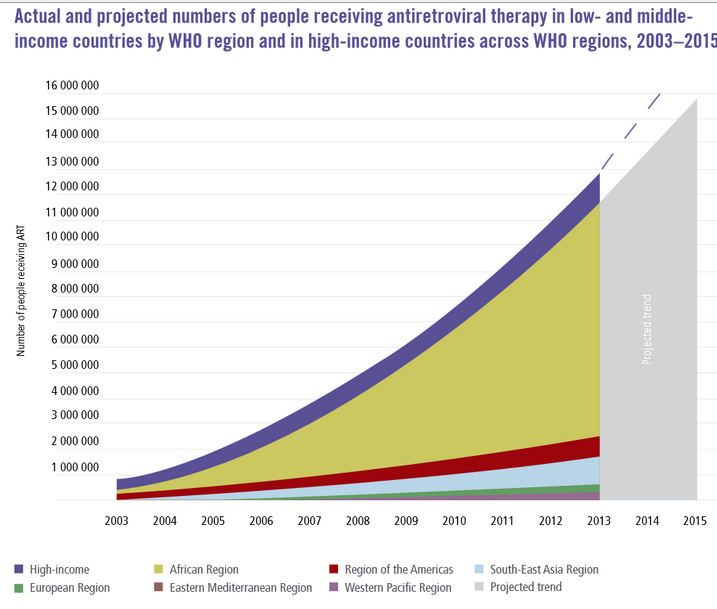
UNAIDS and the WHO estimate that AIDS has killed more than 25 million people since it was first recognized in 1981, making it one of the most destructive pandemics in recorded history. Despite recent improved access to antiretroviral treatment and care in many regions of the world, the AIDS pandemic claimed an estimated 2.8 million (between 2.4 and 3.3 million) lives in 2005 of which more than half a million (570,000) were children.
Epidemiology

Globally, between 33.4 and 46 million people currently live with HIV. In 2005, between 3.4 and 6.2 million people were newly infected and between 2.4 and 3.3 million people with AIDS died, an increase from 2004 and the highest number since 1981.
Sub-Saharan Africa remains by far the worst-affected region, with an estimated 21.6 to 27.4 million people currently living with HIV. Two million [1.5–3.0 million] of them are children younger than 15 years of age. More than 64% of all people living with HIV are in sub-Saharan Africa, as are more than three quarters of all women living with HIV. In 2005, there were 12.0 million [10.6–13.6 million] AIDS orphans living in sub-Saharan Africa 2005. South & South East Asia are second-worst affected with 15% of the total. AIDS accounts for the deaths of 500,000 children in this region. South Africa has the largest number of HIV patients in the world followed by Nigeria.[8] India has an estimated 2.5 million infections (0.23% of population), making India the country with the third largest population of HIV patients. In the 35 African nations with the highest prevalence, average life expectancy is 48.3 years—6.5 years less than it would be without the disease.[9]
The latest evaluation report of the World Bank's Operations Evaluation Department assesses the development effectiveness of the World Bank's country-level HIV/AIDS assistance defined as policy dialogue, analytic work, and lending with the explicit objective of reducing the scope or impact of the AIDS epidemic.[10] This is the first comprehensive evaluation of the World Bank's HIV/AIDS support to countries, from the beginning of the epidemic through mid-2004. Because the Bank aims to assist in implementation of national government programmes, their experience provides important insights on how national AIDS programmes can be made more effective.
The development of HAART as effective therapy for HIV infection and AIDS has substantially reduced the death rate from this disease in those areas where these drugs are widely available. This has created the misperception that the disease has vanished. In fact, as the life expectancy of persons with AIDS has increased in countries where HAART is widely used, the number of persons living with AIDS has increased substantially. In the United States, the number of persons with AIDS increased from about 35,000 in 1988 to over 220,000 in 1996.[11]
In Africa, the number of MTCT and the prevalence of AIDS is beginning to reverse decades of steady progress in child survival. Countries such as Uganda are attempting to curb the MTCT epidemic by offering VCT (voluntary counselling and testing), PMTCT (prevention of mother-to-child transmission) and ANC (ante-natal care) services, which include the distribution of antiretroviral therapy.
Incidence
In the United States in 2009, the incidence of HIV was 15 per 100,000 patients. [12]
Demographics
Gay and Bisexual Men
Gay and bisexual men remain the population most heavily affected by HIV in the United States. CDC estimates MSM represent approximately 2% of the US population, but accounted for more than 50% of all new HIV infections annually from 2006 to 2009 –56% in 2006 (27,000), 58% in 2007 (32,300), 56% in 2008 (26,900) and 61% (29,300) in 2009. [13]
Race
African Americans and Hispanics/Latinos are the racial/ethnic groups most affected by HIV. African Americans represent approximately 14% of the US population, but accounted for 44% (21,200) of all new HIV infections in 2009. Hispanic/Latinos represent approximately 16% of the total US population, but accounted for 20% (9,400) of all new HIV infections in 2009.
Overall, in 2009, African American men had the highest rate of new HIV infections (103.9 new infections per 100,000 persons), followed by Hispanic/Latino men (39.9 per 100,000), and African American women (39.7 per 100,000). [14]
References
- ↑ Palella FJ Jr, Delaney KM, Moorman AC; et al. (1998). "Declining morbidity and mortality among patients with advanced human immunodeficiency virus infection. HIV Outpatient Study Investigators". N. Engl. J. Med. 338 (13): 853&ndash, 860. PMID 9516219.
- ↑ Snyder M, Omoto AM, Crain AL (1999). "Punished for their good deeds: stigmatization for AIDS volunteers". American Behavioral Scientist. 42 (7): 1175&ndash, 1192. doi:10.1177/0002764299042007009.
- ↑ 3.0 3.1 3.2 3.3 3.4 "WHO 2013 statistics".
- ↑ 4.0 4.1 4.2 4.3 4.4 UNAIDS, WHO (December 2007). "2007 AIDS epidemic update" (PDF). Retrieved 2008-03-12.
- ↑ 5.0 5.1 5.2 5.3 "The Centers for Disease Control and Prevention".
- ↑ McNeil DG Jr (2007-11-20). "U.N. agency to say it overstated extent of H.I.V. cases by millions". New York Times. Retrieved 2008-03-18.
- ↑ Kallings LO (2008). "The first postmodern pandemic: 25 years of HIV/AIDS". J Intern Med. 263 (3): 218–43. doi:10.1111/j.1365-2796.2007.01910.x. PMID 18205765.
- ↑ McNeil, Jr., Donald (November 20, 2007). "U.N. Agency to Say It Overstated Extent of H.I.V. Cases by Millions". The New York Times. Retrieved 2008-01-16.
- ↑ UNAIDS (2001). "Special Session of the General Assembly on HIV/AIDS Round table 3 Socio-economic impact of the epidemic and the strengthening of national capacities to combat HIV/AIDS" (PDF format). Retrieved 2006-06-15.
- ↑ World Bank (2005). "Evaluating the World Bank's Assistance for Fighting the HIV/AIDS Epidemic". Retrieved 2006-01-17.
- ↑ Centers for Disease Control and Prevention (1996). "U.S. HIV and AIDS cases reported through December 1996" (PDF format). HIV/AIDS Surveillance Report. 8 (2): 1–40.
- ↑ http://www.cdc.gov/hiv/topics/surveillance/incidence.htm
- ↑ http://www.cdc.gov/hiv/topics/surveillance/incidence.htm
- ↑ http://www.cdc.gov/hiv/topics/surveillance/incidence.htm
- Pages with reference errors
- CS1 maint: Explicit use of et al.
- CS1 maint: Multiple names: authors list
- HIV/AIDS
- Disease
- Immune system disorders
- Infectious disease
- Viral diseases
- Pandemics
- Sexually transmitted infections
- Syndromes
- Virology
- AIDS origin hypotheses
- Medical disasters
- Acronyms
- Immunodeficiency
- Microbiology